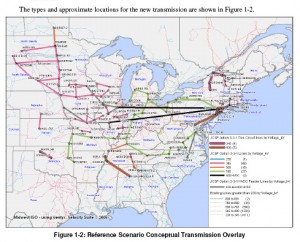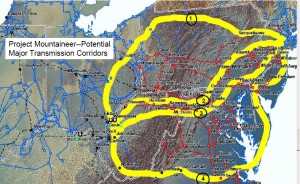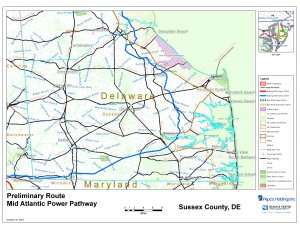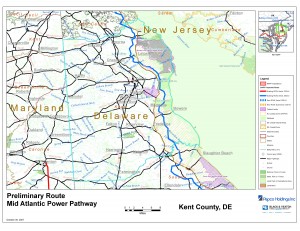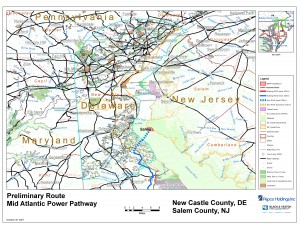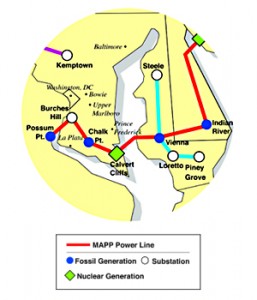Offshore transmission, NOT transmission from Midwest
December 6th, 2009
By standing up for offshore transmission for wind, Delaware’s Gov. Jack Markell stands up to Midwest coal!
The Mid-Atlantic states have been standing up and opposing transmission from the Midwest. They’ve gone on record in a number of venues, and in their opposition are citing Midwest transmission promoters’ disregard for eastern renewable efforts, that xmsn may well not be an economical way to get power to the east, and that THEY KNOW THAT MIDWEST TRANSMISSION PLANS INHERENTLY ARE ABOUT COAL. The plan they’re referring to is a massive transmission buildout known as JCSP, and it also applies to the big PJM buildout that includes the PA-NJ Susquehanna-Roseland transmission line that was the subject of a hearing last month.
Here’s JCSP (Joint Coordinated System Plan) note their site now talks about wind — but look where the transmission starts, DUH! The coal fields of the Dakotas:
Gotta give them, Delaware, Maryland and Virginia, a lot of credit for recognizing and stating what Midwest states have been unwilling to admit.
That said, here’s what Mid-Atlantic states are doing — they’re banding together to propose offshore transmission. If it’s underwater offshore transmission, that’s an idea that’s hard not to like. But I’ll bet it throws PJM for a loop, what with all their “backbone” transmission schemes, a la Project Mountaineer, that are in the works:
The FERC birth of Project Mountaineer:
And you can see that those lines in play now, PJM’s “backbone” transmission projects like Susquehanna-Roseland (NE part of Project Mountaineer Line 1) and MAPP (NE part of Project Mountaineer Line 4) are part of the plan… the big transmission plan that does not work for the east coast.
Here’s the Memorandum of Understanding between Delaware, Maryland and Virginia:
And recently, Gov. Jack Markell addressed these issues before American Wind Energy Association’s offshore windfest — but given the PJM big-transmission-projects-from-hell are referred to as “backbone” projects, I wish they’d find another term:
Delaware energy: ‘Backbone’ power line pushed for wind farms
By AARON NATHANS
The News JournalGov. Jack Markell broached the subject this week in his address to the American Wind Energy Association’s offshore wind workshop, the industry event of the year on this side of the Atlantic. Markell signed onto letters the governors sent to members of Congress this summer, and the Federal Energy Regulatory Commission last month.
“Let’s have the conversation,” O’Mara said. “It’s extremely worthy of further study.”
“It obviously won’t happen in the absence of federal leadership,” he said.
Fishermen’s Energy President Daniel Cohen said it’s a good idea, but “it’s another moving part.”
The benefits of building lines transmitting wind power from the Midwest are less certain, he said.
“It will be difficult to get progress in this area until there are clear national goals,” he said.
Note that “cost allocation” is raised. Since the 7th Circuit decision tossing out FERC approval of PJM’s transmission cost allocation dream/nightmare, all transmission projects 500kV and over based on that cost allocation scheme are in limbo.
So as noted, who pays, and submarine transmission is EXPENSIVE, is THE big issue now. It’s the big issue for land transmission, it’s the big issue for offshore transmission, and, given the uncertainty since the 7th Circuit decision, maybe some of the sturm and drang could be circumvented if it’s designed at 345kV or below, and uses the “benefactor pays” theory. We shall see…
Valero Refinery to close
November 21st, 2009
Back to Delaware for the weekend, it’s very strange being here on the east coast and Alan’s in Red Wing with the grrrrrrrrrls. And speak of the devil, guess who’s in the Philadelphia Inquirer today? The Valero refinery shut down, one of our neighbors works there, well, I’d guess a lot of our neighbors in Port Penn work there, it’s just up the road, they’ve been shut down for a couple of weeks, and now it’s forever. I’m curious what Valero will do — $50 says the try to find a way to walk away from the mess they’ve created. Nearby wells have been contaminated and people are just starting to look around for the source. We’ll see…
550 to lose jobs as Valero Energy shuts Delaware refinery
By Harold Brubaker, Jan Hefler, and Jane M. Von BergenThe Delaware City refinery, which Valero bought in 2005, when the industry’s biggest problem was lack of capacity to keep up with soaring demand, was losing an unsustainable $1 million a day this year, the company said.
Read the rest of this entry »
Delaware “Energy Plan” Comments due TODAY
March 15th, 2009
The Delaware PSC in action, May 2007, saying NO to NRG’s coal gasification proposal.
Delaware’s “Governors Energy Advisory Council” of Toadies and Lobbyists has published what’s called an “Energy Plan.” It’s pretty awful, a hodgepodge of random thoughts that has no budget allocated. It sounds like it was written by Delmarva Power and NRG. So what will happen? Not much, given its stream of unconsciousness ramblings — the justifications below each recommendation are sometimes utterly nonsensical … BUT… that’s what they put out.
COMMENTS ARE DUE TODAY! I know, Sunday, that’s weird, but when Alan called about it that’s what they said, so…
Check the plan and write up something QUICK and send it to:
Sussex Co. transmission meeting tonight
February 4th, 2009
Tonight is the final meeting in the group scheduled by Delmarva Power about the Mid-Atlantic Power Pathway, transmission through Delaware to New Jersey.
Wednesday, February 4 @ 6 p.m.
Millsboro Civic Center
322 Wilson Highway
Millsboro, Delaware
Sussex County:
Kent County:
New Castle County (cutout):
For more info on the underlying scheme, see my prior post:
Transmission – Mid-Atlantic Power Pathway
February 2nd, 2009
Delmarva Power has been hosting meetings about its proposed Mid-Atlantic Power Pathway. The next meeting is:
Wednesday, February 4 @ 6 p.m.
Millsboro Civic Center
322 Wilson Highway
This is an electrical superhighway through Delaware, the map makes that much clear.
What’s interesting is that Rep. Tom Carper seems to be taking an enlightened and informed position on this:
Today, there’s a long piece in the News Journal about it, with the above quote from Carper:
Power-line plan stirs environment fears
Bluewater Wind hails pathway for clean energy

